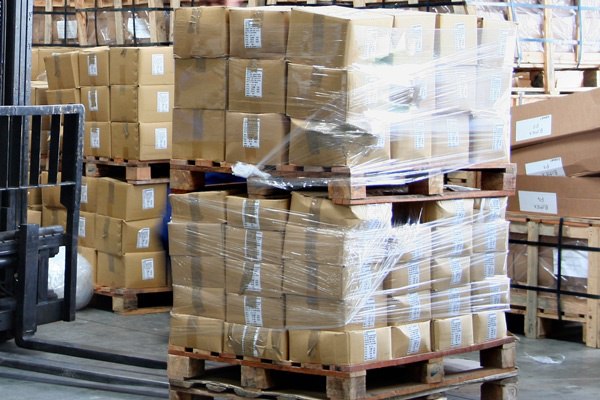Why You Should Have Supplemental Shipping Insurance on Packaged Goods
Equipment | Packaging Materials | The Business of Packaging | Supply Chain Services/ Contract Packaging | Plant Performance | Investment | Air Pillows | Shipping Protection
The last thing that you want to worry about is your product leaving your business or facility and ending up at it’s destination damaged or completely destroyed. Unfortunately this isn't a rare occurence. No matter if it's your fault due to packaging issues or someone elses as it's in handled transit, it's a representation of your product and brand to the person or business receiving it. In fact, pallet loads can even be turned away at the distribution center, costing thousands for one unit. This can not only cause significant delays in delivery, but also potential damage to your business relationships.
When shipping damage occurs you then have to ship out a new product to replace the damaged goods, which can end up costly for your business . The process itself of even looking into where the damage occured or who is liable can be grueling in itself. Additionally, figuring out if the cost will be covered by the carrier or damager and whether they have the insurance to cover it can be a whole other issue in itself. Even if the third party has the insurance to cover it, damaged goods claims can take a bit of time and in most cases, it may be easier to take on the cost yourself for the time spent on monitoring the claim or waiting.
That’s where supplemental insurance comes into play as something that can save you time and peace of mind. Supplmental insurance covers any potential damages or losses after your product begins it’s journey in transit. It's important to proactively look for ways to avoid damage and protect your business from any potential losses during shipment. Look into supplemental shipping insurance and create a strategic plan to help manage your products and pallets more effecitvely, and securely. To be better prepared for this, having an understanding of the various factors that can lead to packaging damage will make your research into supplemental insurance far more effective.
Factors that lead to Packaging Damage
The moment that your product leaves your manufacturing or distribution facility, your product is at risk of damage . There are many factors throughout the supply chain that can lead to this:
- Handling- your products are highly valuable to you and your business, but that feeling may not be reciprocated by the freight carrier you choose. Their drivers and package handlers may simply be unhappy with their day, or simply careless with handling products between your facility and the end-destination. It's a risk you will have to take either way. Make it a point to build a trusting relationship with your carriers and understand the entire handling process of your goods once they leave your facility. As the saying goes, the more you know..
- Shifting around during transportation- Another inevitable risk you must take on when shipping your goods. Your products are often not the only ones being shipped by a carrier and rough travel to and from your facility is bound to happen at some point. Being confident that your palletizing equipment and manual stretch wrappers are managing sound load containment for your products is a must to reduce the impact of products shifting during shipment.

- Retail support and operations- Shipping and receiving at distribution centers is hectic. There are short time windows to load and unload the waiting line of trucks and trying to piece back together a damaged pallet is less effective for time management than simply rejecting the load. Your products making it through the supply chain is dependent on many factors including the retail support operations management of the facilities your product will arrive at during travel, and their equipment. Keep this in mind when designing effective shipping protection.
- Packaging- In reality, having minimal product damage during shipment really comes down to how you are securing your products in preparation for its unknown travel. There are a few things to keep in mind when selecting the packaging materials for your product itself as well as the shipping protection .
- Stretch wrap effectiveness- Monitoring the stretch wrap you use for load containment is important to keeping products safe. If you are using a heavy-gauge film for smaller or thinly contained products, you are bound to see some crushing and deformed packaging being sent back to your facility, rejected by the receiver on the other end of delivery. In other cases, you may not be using enough film, or using too thin of a wrap to properly contain your heavier products. irregular shaped products can make for tricky palletizing, so its important to find the right stretch film with the ideal amount of load containment to keep your products secure throughout the supply chain.
- Stretch wrapper effectiveness- Your pallet wrapper could be causing and costing more than damaged products if it isn't properly used and maintained. Understanding how to set the proper controls for each type of pallet load and having properly trained employees using it is critical to having effective load containment, and a safe work environment. If you don't know how to use a new pallet wrapper, connect with your supplier to find training. In some cases we can send our technicians to train your team at your facility on how to use a pallet wrapper properly, and how to adjust the settings for maximum film usage and reduced load damage. Which segues perfectly with proper maintenance! Maintaining the equipment you use, (even manual pallet-wrappers) is integral to keeping your products secure, and your people. If you don't perform preventive maintenance on yourself or your machines, you are going to run into unexpected downtime, damaged goods, and potential injuries.

- Stackability- The stackability of your products can also determine the effectiveness of palletizing and product protection. Are your products being stacked with too much weight, compressing the products on the bottom of the stacks? Be sure to consider everything when reviewing your packaging for reduced product damage. There are several sizes and types of corrugated shipping containers available with different configurations and thicknesses to reduce impact damage, puncture damage, stackability and more. It may be helpful to review your corrugated options to find the ideal type of containment for your goods.
- Inside the box- Inside the shipping container you use, whether you are placing multiple products in one box or have a lot of open space, its important to secure your product inside the corrugated box as well. Air pillows for shipping are a consumer and end-user friendly way to mitigate product movement during shipment inside a larger box. Fill the void of empty space with something to keep your products securely in one place.
- Unit load design- Do you have a specific process in place for how your pallets are arranged for shipment? If not, it may be worthwhile to implement a load design that is effective at keeping your products secure from too much overhang on the pallet edge. Do what you can to lay out your packaged goods strategically on your pallets and stack to reduce loose products and overhang damage. Interlocking products to produce a sturdier load can prove beneficial in this case.

- Trailer loading pattern- Granted you may have limited ability outside of your facility to manage how the trailers are loaded after leaving your facility, but if you are in control of loading your goods onto the carrier truck, give due diligence to a trailer loading strategy that will help your products stay as secure as possible in transit. Warehouse Optimization created a helpful (and entertaining) truck loading guide with some helpful tips for loading a truck effectively.
What is Supplemental Insurance

- Supplemental Insurance provides you with an umbrella over your entire distribution chain
- This will cover any damages from the moment that your package leaves your facility to the moment it gets to it’s destination so that you don’t have to worry about relying on the insurance of third parties in order to get the loss covered right away
- Typically supplemental insurance is affordable and in the long run saves your business money on potential losses and time spent dealing with claims
Why it’s important

You don’t have to go through the process of determining at what part in the distribution process your goods were damaged and who is liable.
In order to recoup loss of your damaged goods from the party responsible you will have to file a claim - which can take time out of your busy day to deal with and to keep track of and not to mention it interrupts the flow of your distribution
It can take time for a claim to be solved - months even years. You are going to want to get the damage covered in a timely manner and not have to wait a long amount of time to even see it come through to keep your business running efficiently
It isn’t going to be just one product that has damage every few years - product damage occurs frequently in the distribution chain and so you have to keep tabs on all of the claims you may have with different people in order to get money to cover the damages.
Conclusion:
There are many different factors that come into play as your package leaves your facility to the time it gets to it’s destination. Your hope is that it arrives to your customer in the best shape possible and that you don’t have to reship any damaged items - but unfortunately it is a reality that damages will occur in the process. This is why it’s important to have a plan to efficiently and be proactive to keep your operations running smoothly. Supplemental insurance can save you headaches in the long-run by knowing that you don’t have to wait to see losses recovered.
Want a head start on understanding and implementing effective protective packaging?
Check out the Ultimate Guide To Protective Packaging, totally free!
About David Roberge
I am grateful to be part of the outstanding Industrial Packaging team. I am able to hang out with some of the most knowledgeable folks in the packaging industry. I feel even luckier that I am able to share that knowledge with you. I love learning, hiking, and growing people and teams both personally and professionally, and helping companies grow better.



